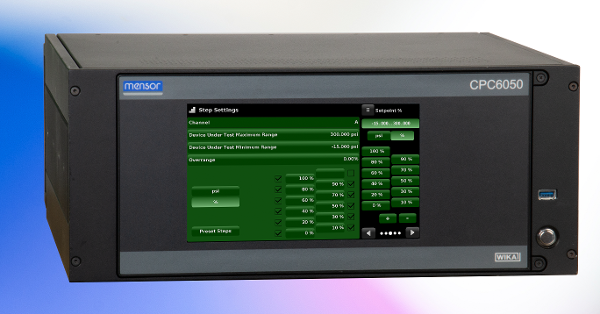When testing and calibrating low pressure transducers, it’s important the range of the reference standard encompass the range of the device under test (DUT). An indicator or controller used as a reference standard will often have a wider range in order to perform other tasks and calibrations. Low pressure sensors, because of their nature, are susceptible to damage from overpressure, which could render them inoperable or inaccurate.
Without the proper safety mechanisms and processes, it’s easy for a reference instrument to apply pressure beyond the range of a transducer. This can deform or destroy a transducer’s diaphragm. To combat this problem, Mensor’s instrument design and software includes many features that protect sensitive pressure devices from being overpressured during calibration and testing. These features include:

External Relief Valve
An external relief valve is a mechanical safety device that will prevent the pressure from going above the relief valve set pressure. This pressure can be set to reflect the maximum allowable pressure in the DUT. It can be installed on the Measure/Control port of the reference device and will be inline with the DUT. This can be ordered as an accessory for some Mensor products, like the CPG2500.
All Mensor controllers have an internal relief valve that are designed to protect the reference sensor if there are ever software or hardware failures that would cause the pressure to spike outside the internal transducer's pressure range. The relief valves in Mensor devices are set to a pressure that will prevent the internal transducer from getting damaged. However, it will not guarantee the user DUTs from being exposed to overpressure.
Minimum and Maximum Limits
With Mensor’s controller software, the user can set their own minimum and maximum pressures in order to limit the pressure range of the controller. This setting, typically found under “Control Settings,” disables the entry of a pressure value outside of these limits.
These limits can be set as part of different configurations within the Mensor Controllers and saved to the instrument’s memory. As an example, if you have four distinct ranges of sensitive DUTs, a configuration for each of those can be stored in the controller and recalled prior to calibrating.
Range Hold
This is a feature in many pressure controllers that allows the reference device to lock onto one of the internal transducers. This will prevent the controller from going outside the range of the active internal transducer. For example, if the DUT range matches the internal reference sensor range, Range Hold can add a level of protection for the DUT.
Step, Jog and Nudge
This is a feature built into some pressure controllers that allows the instrument to be "nudged" a small step to find the cardinal point of the DUT. If a controller has a resolution of 6 digits, and has a 10 psi instrument, they will be able to make steps as small at 0.0001 psi. By doing this, the customer can get close to the maximum pressure, then switch to the nudge feature and make very fine adjustments to prevent overpressure.
Overpressure Vent
This software feature is built into most pressure controllers. The software will automatically vent the system if the internal reference transducer detects a pressure outside its operating range. This threshold is typically between 1 and 10% of the internal sensor range. Some controllers also provide this feature based on the pressure rate, rather than the peak pressure. If the instrument detects a significant spike in pressure, it can automatically vent to prevent any other damage.
Conclusion
All of these features, whether they are engineered into the instrument, offered as an accessory, or designed into its software, were created to enable the user to take more control over their calibrations and measurements, as well as protect their DUTs from bursts, leaks and other costly damage that could occur during testing.
Related Reading:
- What is the True Cost of Owning an Automatic Pressure Calibrator?
- The Importance of Modularity in Pressure Calibrators and Controllers
- Contamination Prevention: Extend Life of Pneumatic Pressure Calibrators
- Pressure Safety: How to Protect Devices from Overpressure
- Choosing the Right Filtration Type for Pneumatic Instruments



